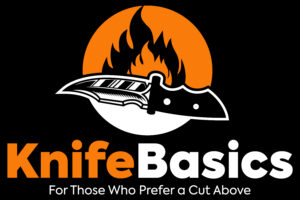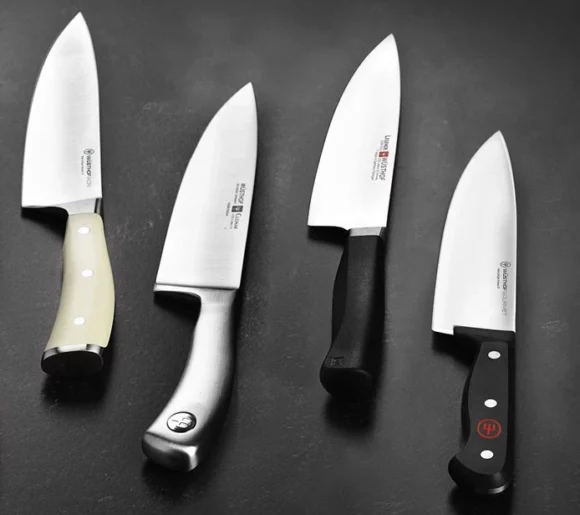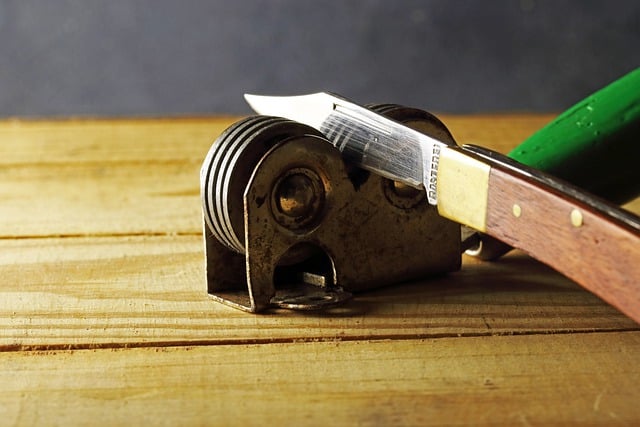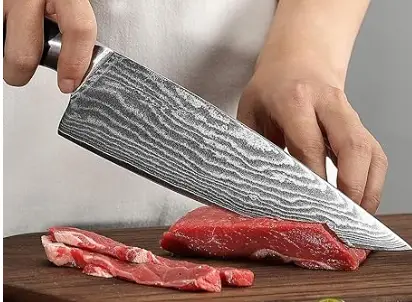Forged and stamped knives are two different types of knives manufactured in different ways. Forged knives are made by heating steel bars and then hammering them into shape, while stamped knives are made by cutting steel sheets and then stamping them into shape.
The main differences between the two types of knives include blade material, weight, thickness, tang, bolster, edges, and cost. Forged knives are often heavier and thicker with full tangs and bolsters, sharper edges, and made with high-carbon steel.
They are also more expensive than stamped knives. Stamped knives, on the other hand, are lighter and thinner with partial tangs, rarely have bolsters, and are made with stainless steel. They are ideal for regular kitchen tasks and are less expensive.
So, forged vs. stamped knives, which is the best choice? Let us address the questions by looking at the features of each knife.
How Forged Knives Are Made
Craftsmen use steel bars in making forged knives. The forging process involves heat-treating the bar before hammering and grinding it into shape. Traditional artisans use the hot drop forging technique.

First, the artisans heat the steel bar and then hammer it into shape. The knife then goes through several sharpening procedures. The manual hot drop forging procedure is quite tedious.
But thanks to modern technology, this process has been simplified through machines. Regardless of the machine interventions, the forging process has remained the same.
How Stamped Knives Are Made
Stamped knives are made from a large sheet of steel. The producers cut the steel sheet using a laser. They then use machines to stamp out the sheet to the shape of a knife. After that, the shaped blade goes through the hardening, tampering, and sharpening process.

Like forged knives, stamped knives go through the heating process to achieve durability. But the hardening process requires less heat than the forging process.
Forged vs. Stamped Knife- What Is The Difference?
Below are some features that differentiate between the two types of knives.
The Blade Material
Manufacturers use different materials in making forged and stamped knives. The forged knives are made using carbon steel, stainless steel and high carbon steel. These materials can withstand high levels of heat treatment.
Stamped knife manufacturers often use stainless steel in the making of the blade. Compared to high-carbon steel, stainless steel is more affordable. Also, the steel does not have to go through high levels of heat treatment in the blade formation.
Weight
The other difference between the stamped and forged knives is the weight. The material, tang, bolster, and thickness of the blade determine the knife’s weight.
Forged knives are often heavier than their stamped counterparts for the same blade size. This extra weight comes through when cutting thick food ingredients. Thus, forged knives are ideal for making butcher and hunting knives.
But the stamped knives are lighter and easier to handle. Thus, you can work for a stamped knife for a long time without exhaustion. As such, these knives are ideal for regular kitchen tasks. They are also perfect for busy restaurants whereby you have to work for extended periods.
Thickness
Generally, forged knives are thicker and harder than stamped knives. This extra thickness makes the knife more durable. The thickness also creates more balance and stability in the knife. These features make the forged knives ideal for chopping and slicing vegetables.
The stamped knives are much thinner. As such, these knives are more flexible and more bendable. This flexibility makes the stamped knives ideal for filleting tasks. The thin blades are ideal for precision cutting. Thus, you may want to use a stamped knife in the preparation of salads.
Tang
A tang is the part of the blade that runs through the handle. A full tang runs through to the end of the handle. But a partial tang only runs halfway through the handle. You can check the tang type by looking at the top and bottom parts of the handle. A full tang is visible on both parts of the handle. A partial tang is only visible at the top part of the handle.
Tangs ensure that the blade and the handle do not detach. They also offer stability and balance to the handle. Thus, a full tang knife is more balanced than a partial tang.
Most forged knives feature a full tang. Thus, forged knives are more balanced and stable. But most stamped knives have a partial tang. As such, they are not as well balanced and stable as the forged knives. Also, partial tangs can loosen and detach from the handle after use.
Bolster
A bolster is a buffer between the handle and the blade. Bolsters can be made from plastic, wood, and metal. But most knife producers prefer metal bolsters. The extra weight of bolsters increases the stability of the knife. Also, bolsters act as the finger guard, protecting you from injuries if the fingers slip.
Forged knives often feature bolsters. These bolsters are often forged as a single part with the rest of the blade.
The stamped knives rarely feature a bolster, as the blade is stamped out at equal thickness. But some manufacturers add the bolsters as a separate part from the blade.
Edges
Forged knives tend to have sharper edges than stamped knives. The forged knife blade is generally thicker at the top and tapers down to the edge. The forged knives undergo intense heat treatment, resulting in high hardness. Thus, the forged knives are not only razor sharp but keep edges for a long time.
Cost
Forged knives are more expensive than stamped knives, with prices ranging from $50-$200, depending on the brand and type of knife. Stamped knives are more affordable, with prices ranging from $20-$80.
The difference in price can be attributed to the difference in materials used, the manufacturing process, and the heat treatment. Forged knives are made from high-carbon steel, which is more expensive and less available in the market.
The forging process uses more heat, which also contributes to the overall cost of the knife. Stamped knives are made from stainless steel, which is more affordable and common in the market.
Advantages of forged knives:
- Forged knives are generally heavier than stamped knives, which makes them ideal for chopping and slicing tasks.
- They have a full tang, making them more balanced and stable.
- They often feature bolsters, providing added stability and serving as a finger guard.
- The edges of forged knives tend to be sharper and maintain their sharpness for a longer time.
Disadvantages of forged knives:
- Forged knives are often more expensive than stamped knives.
- The heat treatment process used in forging results in a higher cost of production.
Advantages of stamped knives:
- Stamped knives are lighter and easier to handle, making them ideal for regular kitchen tasks and for busy restaurants where you have to work for extended periods.
- They are more flexible and bendable, making them ideal for filleting tasks.
- The thin blades are ideal for precision cutting.
Disadvantages of stamped knives:
- Stamped knives often have a partial tang, which can result in a lack of balance and stability.
- They rarely feature bolsters, leaving the user exposed to injuries in case the fingers slip.
- The edges of stamped knives are not as sharp as those of forged knives.
Forged vs. Stamped Knife- Which one is better?
Secondly forged knives offer better weight distribution between the handle and the blade due to the full tang design and the presence of a bolster. This gives the user better control during a cutting task and is especially preferred when cutting thick foods.
Forged knives will give you extra sharp edges that will serve you for ages. But for this to happen, you must take good care of the blade. Most forged knives are high carbon steel thus prone to rust and requires extra care to sustain you for a long time.
If you want a lightweight knife that you can use for long periods, you can go for a stamped knife. But this choice will also mean that the knife may need constant sharpening as it does not keep the edges for long.
Another consideration that you need to make is the cost of the knife. As we have seen, forged knives are often more expensive than stamped ones due to the involved process of production.
Maintenance And Safety Of Forged Knives
Forged knives are known for their durability and long-lasting sharpness. However, these knives require proper maintenance to keep them in top condition. Forged knives are harder than stamped knives and require more maintenance to keep the edges sharp.
It is recommended to hand-wash and dry the forged knives after use to prevent rust and corrosion. The blades should be honed regularly using a honing steel to maintain their sharpness.
Safety is a crucial aspect of using forged knives. The bolsters act as a finger guard to prevent injuries if the fingers slip. However, it is important to handle the knife carefully and avoid sharpening the bolsters, as they may lose their stability.
Maintenance and Safety of Stamped Knives
Stamped knives are easy to maintain and are often dishwasher safe. However, it is recommended to hand-wash and dry the knives after use to prevent rust and corrosion. The blades should be honed regularly using a honing steel to maintain their sharpness.
Safety is a concern when using stamped knives, especially because they do not have bolsters. It is important to handle the knife carefully and maintain a firm grip on the handle to prevent slipping. The partial tang can loosen after frequent use, making the knife unstable and posing a potential danger.
Conclusion
When pitted against each other, forged vs Stamped knives, forged knives take the lead. However, before choosing between the two, you must understand the purpose of the knife. Stamped knives are lighter and maybe most suitable for busy kitchens with lots of cutting.



